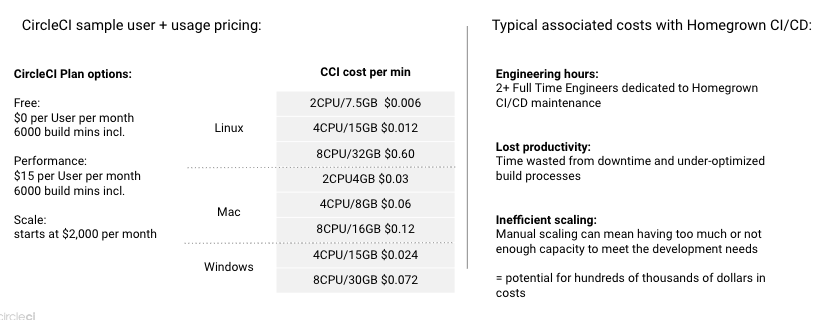Continuous Integration/Continuous Delivery (CI/CD) has become an essential part of modern software development, allowing teams to deliver high-quality code at a faster pace. Teams can either build or buy their CI/CD system. In this blog post, we will compare both options - exploring the advantages and disadvantages of each - and why CircleCI may be the better choice.
Why homegrown CI/CD?
The most common reasons for companies to develop their own homegrown CI solution are compliance, cost, faster feedback loop and satisfying niche use cases. Many such companies are early-stage startups though more traditional companies have been known to adopt this model also. Companies like these find that it is easier to onboard their developers to such a solution as it does not require expertise in third party solutions and they can use on-premise compute that is not exposed to the Internet. Within this model, they also tend to take a monolithic approach to storing their code to make it easier for development teams to carry out building and testing.
The hidden costs of homegrown CI/CD
This model generally suits very self-sufficient teams who are happy to manage the security and ongoing maintenance of the solution as well as their coding. But while a homegrown solution can be optimized for a team’s unique needs, it can also become antiquated and require significant time and resources to maintain, making the development of efficiencies very difficult.
Companies deploying this model often find that builds are lengthy and unstable, making performance difficult to track. Additionally, developing new functionality when needed requires significant time and resources, especially when new libraries and integrations have to be written.
Also, because individual small pieces of code for the tool may have been programmed by different people at different times, the solution can become fragile, requiring frequent debugging. Furthermore, once a homegrown tool is optimized for a few specific tasks, it can struggle to keep up with evolving company growth and the demands which come with that. Teams can invest increasing amounts of time in keeping a homegrown solution operational, detracting from the value the tool was initially meant to provide.
This leads to a lot of intangible costs such as hiring of additional engineers to cover both the homegrown system maintenance and ongoing product development work as well as loss of market share resulting from not being able to release features as quick as you would like or the inability of the system to support up to date platforms in order to stay competitive.
Generally speaking, homegrown CI/CD solutions are likely built with thousands of lines of imperative scripts which can eventually lead to the incurring of significant technical debt. They usually run within the company’s private network, lack a modern GUI and cannot dynamically scale. They also likely do not have metrics tracking functionality, making it very hard to gauge the performance of the development team over time.
The advantages of CircleCI
In contrast to a homegrown solution, CircleCI is a stable, mature, and reliable CI/CD platform designed for seamless integrations. It is also the fastest CI/CD on the market and includes an Insights feature that monitors performance. CircleCI is easily scalable to meet evolving needs and offers a flexible and scalable CI/CD platform to support your team’s unique requirements and complex use cases. CircleCI cloud alleviates infrastructure management from your team, and our server offering offers a seamless CI/CD experience with less maintenance compared to open source solutions.
Pricing is also a significant factor to consider when comparing build or buy CI/CD solutions. CircleCI has free and paid plans, with a per-user + usage-based pricing model. Homegrown solutions do not incur recurring payments, but require significant ongoing maintenance to keep evergreen and secure. This consumes cost, time and resources and limits return on investment.

Build or buy: Real-life success stories after migrating to CircleCI from homegrown solutions
Struggling with the limitations of their custom-build CI/CD solution and Jenkins, Netguru, a leading digital transformation company, turned to CircleCI for a powerful, flexible, and customizable solution. With CircleCI, they saw significant improvements in testing time, reducing wait time by 75%, and achieved their clients’ digital transformation goals with a faster feedback loop and faster delivery. CircleCI’s automation streamlined their integration and delivery pipeline, allowing for greater concurrency and increased performance.
nCino, a leading cloud banking software company, suffered from a manual, error-prone CI/CD process. They needed a solution that would provide automation, scalability, and flexibility. After implementing CircleCI, they saw a significant reduction in the time it took to deliver features, from weeks to just a few days.
“CircleCI is a developer’s CI tool,” says nCino’s Director of Release Management, Brian Triplett. “Having your build definitions, build script, and YAML file in source control makes it so that it’s really easy for developers to get started. There isn’t a system out there that’s been tinkered with by somebody and configured by somebody else, where no one really knows how anything works because the master architect set it up a year ago.”
Conclusion
Within the realm of CI/CD solutions, organizations often face the ‘Build vs Buy’ conundrum when considering their options. While homegrown solutions can be useful for specialized use cases, they come with several drawbacks, including instability, fragility, and the need for significant time and resources to build and maintain. CircleCI offers a flexible and scalable CI/CD platform designed for seamless integrations, performance monitoring, and scalability to meet your team’s evolving needs. With CircleCI, your developers can focus on delivering value to your customers without having to worry about the tooling, environment or compliance requirements.
Start building with pipelines on CircleCI
If you’re new to continuous integration, understanding what pipelines do and are capable of will help you understand the true value of CI. To learn more, visit the CircleCI resources page. To get started, check out our docs.








